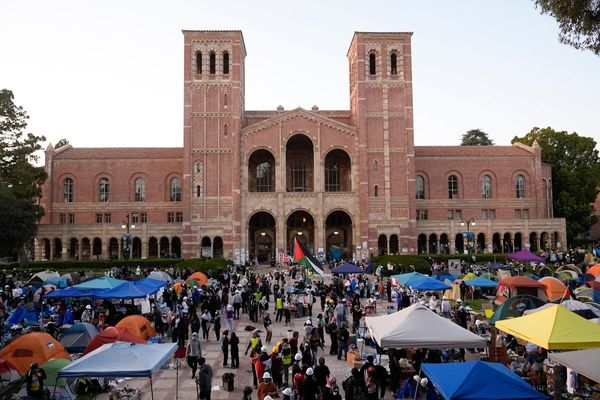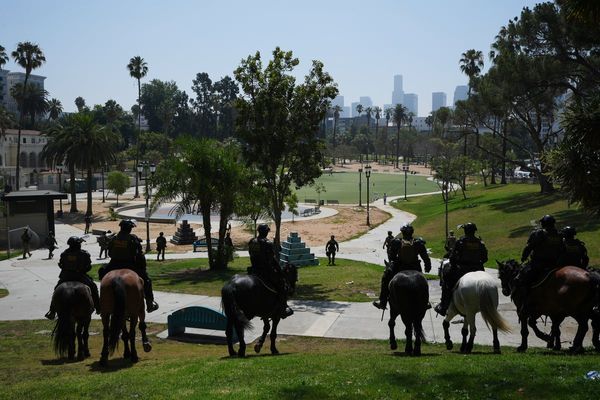There's a greater chance thylacines, known as Tasmanian tigers, could have been saved from extinction if the pleas of renowned naturalist David Fleay had been heard, his son says.
One of Stephen Fleay's earliest memories is of his father's four-month search for a pair of thylacines, starting in November 1945, when Stephen was three years old.
His father had lobbied authorities unsuccessfully to protect the species and was "bitterly disappointed" when he was unable to find a breeding pair, despite evidence the animal still existed.
Now in his 70s, Mr Fleay, remembers a determined father who prioritised animals and spoke with urgency about the need to protect Australian fauna.
"We had a good upbringing, us kids, but the animals always had priority. He never had a holiday his whole life," Mr Fleay said.
"He'd been collecting animals, birds and reptiles since he was a child, probably seven or eight years of age. He lived in Ballarat and had a menagerie in his home."
His fascination with fauna became a career and in 1944 the naturalist made headlines as the first person to successfully breed platypus in captivity, during his tenure as director of Healesville Sanctuary in Victoria.
"That was world news in the middle of World War II," Mr Fleay said.
Meeting the last-known thylacine
Some of the best-known video and photographs of a thylacine, shared globally today, came about when the young naturalist visited the Hobart Zoo in 1933.
Dr Fleay had the opportunity to visit the cage of Benjamin, the world's last-known surviving thylacine.
He recorded six photographs and film footage showing a remarkable creature in a sad environment.
In the footage Benjamin yawns, paces, lays and stands in a completely bare enclosure with a cracked concrete floor.
"He wrote in an article that Benjamin, the thylacine, was starving – he didn't actually say it was starving literally, but he said it had not a suitable diet," Mr Fleay recalls.
"He longed to get this particular one to mainland Australia, through to the Healesville Sanctuary, so he could feed it on a proper diet."
The thylacine remained at Hobart Zoo until its death in 1936, and although the naturalist was unable to relocate Benjamin, he was left with a permanent reminder of his encounter with the animal.
"He said he was honoured to have been bitten on the backside by this noble creature," Mr Fleay said.
A hunt in thylacine country
Almost a decade after Benjamin's death, a Tasmanian newspaper reported the imminent arrival of a party of "tiger hunters", led by Dr Fleay, who hoped to find a pair of thylacines.
If captured, the animals would be taken to Healesville Sanctuary to attempt captive breeding of the vanishing species.
The family camped in the "silent south-west" in "Jane River country" as described by Dr Fleay.
"Jagged mountains reared their bare, stony tops in awe-inspiring grandeur; where the rivers so often in flood rushed through rocky myrtle-grown gorges; and where, away from the few tracks, progress was limited to a painful struggle through clinging Bauera and mazes of horizontal scrub," the naturalist wrote.
He believed this area of Tasmania to be the "tigers' last stronghold" and told of accounts from local bushmen who said they had seen thylacines there six years earlier.
Stockades with sheep and poultry inside were used to lure thylacines to areas where cage traps were set to humanely capture the marsupial without injury.
A 'most extraordinary cry'
While a breeding pair was not found, Mr Fleay recalls there was trace evidence the thylacine was still in existence.
"He got footprints, droppings and there was the most important evidence, hair on the trap," Mr Fleay said.
"I seem to remember that he even heard them, their call is quite an unusual call."
In Dr Fleay's own reporting of the expedition, he speaks of that moment with wonder:
"That night, as we sat before the fire, there came from an adjacent high hillside a most extraordinary cry," the naturalist wrote.
"It suggested the brief, sharp creak of a door and was quite unlike any cry of a mammal or bird I had ever heard.
"Here at last, it seemed, we were listening to the cry of an animal that in our estimation was almost a phantom."
Sounding the alarm
After the unsuccessful search, Dr Fleay was "bitterly disappointed", a feeling compounded by a 10-year effort to alert the Tasmanian authorities to his concerns about thylacines.
In June 1934, Dr Fleay wrote to wildlife advocate and grandson of the former Premier, William Crowther, asking for his assistance to urge authorities to act and prevent extinction.
"Somebody should make a serious effort to study thylacines before they pass out for ever," Dr Fleay wrote.
It appears the letter did not spur action and that serious effort, once again pursued by Dr Fleay, came many years too late.
By 1953, Dr Fleay began to believe thylacines might be gone forever. They were declared extinct in 1986.
A life devoted to animals
From his home in Portugal, Mr Fleay works to highlight his father's conservation efforts.
In 2017, he received a letter from David Attenborough referring to his father's first publication, We Breed the Platypus, as "one of the most treasured books" of his childhood.
"He [my father] would have been really thrilled," Mr Fleay said.
"He devoted his whole life to the study of Australian fauna, the preservation, conservation and the existence of species.
"He was like a Noah, a Noah's Ark of Australian fauna."
The Fleay family continues to be associated with conservation efforts in Australia today, through the David Fleay Wildlife Park in Queensland and the endangered Tasmanian wedge-tailed eagle, Aquala audax fleayii, which is named in Dr Fleay's honour.
"He was before his time and he did absolutely wonderful conservation work," Mr Fleay said.







